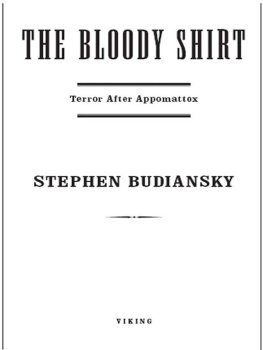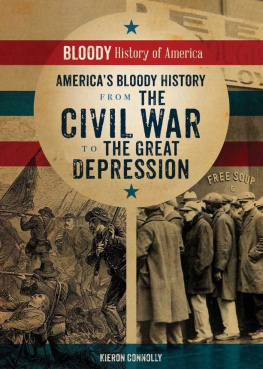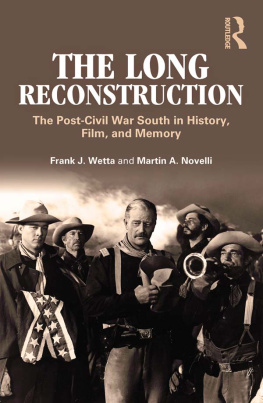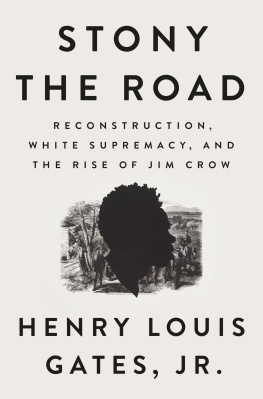Her Majestys Spymaster: Elizabeth I, Sir Francis Walsingham, and the Birth of Modern Espionage
Air Power: The Men, Machines, and Ideas that Revolutionized War, from Kitty Hawk to Iraq
THE BLOODY SHIRT
Terror After Appomattox
STEPHEN BUDIANSKY

VIKING
VIKING
Published by the Penguin Group
Penguin Group (USA) Inc., 375 Hudson Street, New York, New York 10014, U.S.A. Penguin Group (Canada), 90 Eglinton Avenue East, Suite 700, Toronto, Ontario, Canada M4P 2Y3 (a division of Pearson Penguin Canada Inc.) Penguin Books Ltd, 80 Strand, London WC2R 0RL, England Penguin Ireland, 25 St. Stephens Green, Dublin 2, Ireland (a division of Penguin Books Ltd) Penguin Books Australia Ltd, 250 Camberwell Road, Camberwell, Victoria 3124, Australia (a division of Pearson Australia Group Pty Ltd) Penguin Books India Pvt Ltd, 11 Community Centre, Panchsheel Park, New Delhi-110 017, India Penguin Group (NZ), 67 Apollo Drive, Rosedale, North Shore 0632, New Zealand (a division of Pearson New Zealand Ltd) Penguin Books (South Africa) (Pty) Ltd, 24 Sturdee Avenue, Rosebank, Johannesburg 2196, South Africa
Penguin Books Ltd, Registered Offices: 80 Strand, London WC2R 0RL, England
First published in 2008 by Viking Penguin, a member of Penguin Group (USA) Inc.
Copyright Stephen Budiansky, 2008
All rights reserved
ISBN: 978-1-1012-1393-3
Without limiting the rights under copyright reserved above, no part of this publication may be reproduced, stored in or introduced into a retrieval system, or transmitted, in any form or by any means (electronic, mechanical, photocopying, recording or otherwise), without the prior written permission of both the copyright owner and the above publisher of this book.
The scanning, uploading, and distribution of this book via the Internet or via any other means without the permission of the publisher is illegal and punishable by law. Please purchase only authorized electronic editions and do not participate in or encourage electronic piracy of copyrightable materials. Your support of the authors rights is appreciated.
For Lewis Lord
THE BLOODY SHIRT
Prologue
The title of this book refers to a small footnote to the brutal war of terrorist violence that was waged in the American South in the years immediately following the Civil War.
The terror began almost as soon as the Civil War ended in 1865; it lasted until 1876, when the last of the governments of the Southern states freely elected through universal manhood suffrage was toppled in a well-orchestrated campaign of violence, fraud, and intimidationthereby putting an end to Reconstruction, erasing the freedmens newly won political rights, and securing white conservative home rule to the South for a hundred years to come.
In some ways the small incident in question was no different from thousands of others like it that took place in those years. At ten oclock on the night of March 9, 1871, a band of 120 men on horseback, disguised, heavily armed, even their horses cloaked in white sheets to conceal any identifiable markings, surrounded the house of one George R. Ross deep in the river-cut country southeast of the town of Aberdeen in Monroe County, Mississippi. Allen P. Huggins, a Northern man who had settled in Mississippi after the war, was staying the night there, and he was awakened by a loud voice calling upon Ross to bring out the man who was in the house.
Huggins looked out the window and, by the bright moonlight, saw the porch crowded with men in white hoods and robes. They told him that unless he came out to receive their warning, they would burn the place down.
Rossa good, respectable Democratpleaded with Huggins to do as they asked and spare his frightened wife and children. So after securing a promise that not a hair of your head shall be injured, Huggins agreed to go down to the gate to hear what the men had come to tell him. It was just this. The menwhom Huggins would later describe as gentlemanly fellows, men of cultivation, well educated, a much different class of men than I ever supposed I would meet in a Ku-Klux gangdid not like his radical ways, they said. As superintendent of schools for the county, Huggins had instituted public schooling, was trying to educate the negroes, they said. They had stood it just as long as they were going to. Now he had ten days to leaveleave the county, leave the state altogetheror be killed.
Huggins replied that he would go when he was good and ready to go.
So the men marched him down the road, and when they reached a small hill a quarter of a mile away, one of them came toward him from where the horses were being held, and in his hand was a stout stirrup leather. And without any further ceremony, he began beating Huggins with the stirrup, with all his might.
Then the men took turns, each eager to get his licks in. They said they all wanted to get a chance at me, Huggins recalled afterward, that I was stubborn, and just such a man as they liked to pound. Counting aloud each stroke, they stopped after twenty-five and again asked him if he would leave and again he refused; and so after fifty, and so after seventy-five, until he was left senseless, more dead than alive. When he came to, the men trained their pistols on him and repeated their warning, that if any of them laid eyes upon him in ten days time, he was a dead man.
And the sequel was thisor at least this was the story everyone in Monroe County believed, and in time everyone in Mississippi and the whole South had heard it, too: that a U.S. Army lieutenant who was stationed nearby recovered the bloody nightshirt that Huggins had worn that night, and he carried it to Washington, D.C., where he presented it to Congressman Benjamin F. Butler, and in a fiery speech on the floor of the United States Congress a few weeks later in which he denounced Southern outrages and called for passage of a bill to give the federal government the power to break the Ku Klux terror, Butler had literally waved this bloodstained token of a Northern mans suffering at the hand of the Ku Klux. And so was born the memorable phrase, waving the bloody shirt.
Waving the bloody shirt: it would become the standard retort, the standard expression of dismissive Southern contempt whenever a Northern politician mentioned any of the thousands upon thousands of murders, whippings, mutilations, and rapes that were perpetrated against freedmen and freedwomen and white Republicans in the South in those years. The phrase was used over and over during the Reconstruction era. It was a staple of the furious and sarcastic editorials that filled Southern newspapers in those days, of the indignant orations by Southern white political leaders who protested that no people had suffered more, been humiliated more, been punished more than they had. The phrase has since entered the American political lexicon as a synonym for any rabble-rousing demagoguery, any below-the-belt appeal aimed at stirring old enmities.
That the Southerners who uttered this phrase were so unconcerned about the obvious implications it carried for their own criminality, however, seems remarkable, for whoever was waving the shirt, there was unavoidably, or so one would think, the matter of just whose blood it was, and how it had gotten there. That white Southerners would unabashedly trace the origin of this metaphor to a real incident involving an unprovoked attack of savage barbarity carried out by their own most respectable members of Southern white society makes it all the more astonishing.











